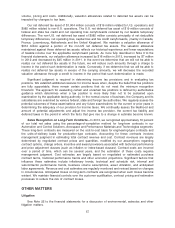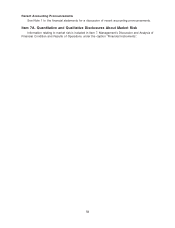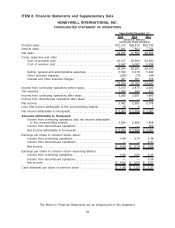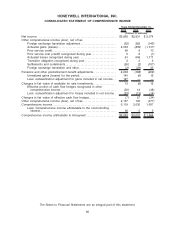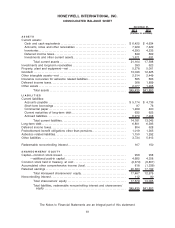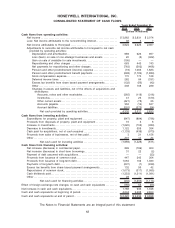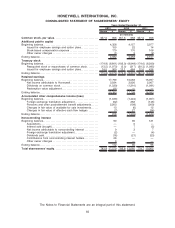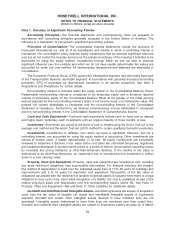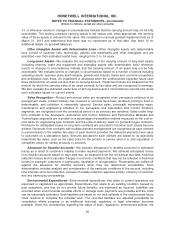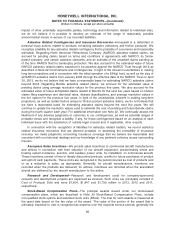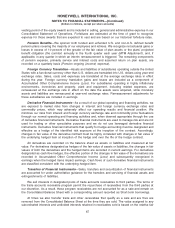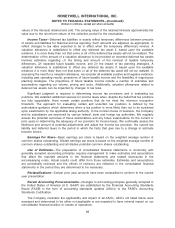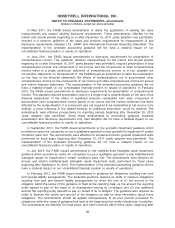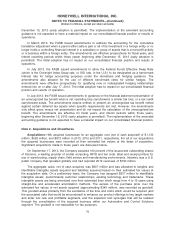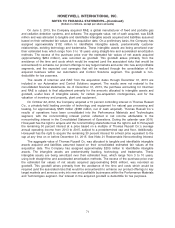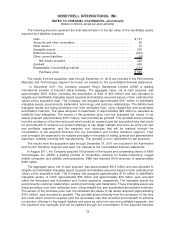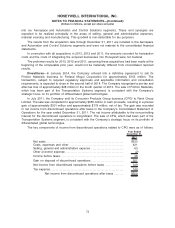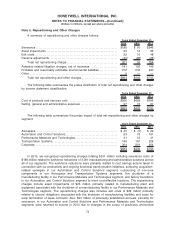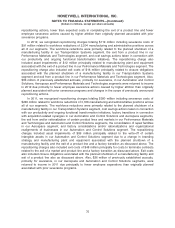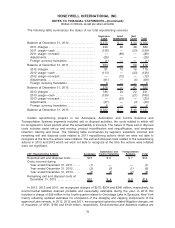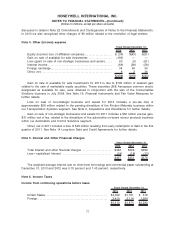Honeywell 2013 Annual Report Download - page 79
Download and view the complete annual report
Please find page 79 of the 2013 Honeywell annual report below. You can navigate through the pages in the report by either clicking on the pages listed below, or by using the keyword search tool below to find specific information within the annual report.vesting period of the equity award) and is included in selling, general and administrative expense in our
Consolidated Statement of Operations. Forfeitures are estimated at the time of grant to recognize
expense for those awards that are expected to vest and are based on our historical forfeiture rates.
Pension Benefits—We sponsor both funded and unfunded U.S. and non-U.S. defined benefit
pension plans covering the majority of our employees and retirees. We recognize net actuarial gains or
losses in excess of 10 percent of the greater of the fair value of plan assets or the plans’ projected
benefit obligation (the corridor) annually in the fourth quarter each year (MTM Adjustment), and, if
applicable, in any quarter in which an interim remeasurement is triggered. The remaining components
of pension expense, primarily service and interest costs and assumed return on plan assets, are
recorded on a quarterly basis (Pension ongoing (income) expense).
Foreign Currency Translation—Assets and liabilities of subsidiaries operating outside the United
States with a functional currency other than U.S. dollars are translated into U.S. dollars using year-end
exchange rates. Sales, costs and expenses are translated at the average exchange rates in effect
during the year. Foreign currency translation gains and losses are included as a component of
Accumulated Other Comprehensive Income (Loss). For subsidiaries operating in highly inflationary
environments, inventories and property, plant and equipment, including related expenses, are
remeasured at the exchange rate in effect on the date the assets were acquired, while monetary
assets and liabilities are remeasured at year-end exchange rates. Remeasurement adjustments for
these subsidiaries are included in earnings.
Derivative Financial Instruments—As a result of our global operating and financing activities, we
are exposed to market risks from changes in interest and foreign currency exchange rates and
commodity prices, which may adversely affect our operating results and financial position. We
minimize our risks from interest and foreign currency exchange rate and commodity price fluctuations
through our normal operating and financing activities and, when deemed appropriate through the use
of derivative financial instruments. Derivative financial instruments are used to manage risk and are not
used for trading or other speculative purposes and we do not use leveraged derivative financial
instruments. Derivative financial instruments that qualify for hedge accounting must be designated and
effective as a hedge of the identified risk exposure at the inception of the contract. Accordingly,
changes in fair value of the derivative contract must be highly correlated with changes in fair value of
the underlying hedged item at inception of the hedge and over the life of the hedge contract.
All derivatives are recorded on the balance sheet as assets or liabilities and measured at fair
value. For derivatives designated as hedges of the fair value of assets or liabilities, the changes in fair
values of both the derivatives and the hedged items are recorded in current earnings. For derivatives
designated as cash flow hedges, the effective portion of the changes in fair value of the derivatives are
recorded in Accumulated Other Comprehensive Income (Loss) and subsequently recognized in
earnings when the hedged items impact earnings. Cash flows of such derivative financial instruments
are classified consistent with the underlying hedged item.
Transfers of Financial Instruments—Sales, transfers and securitization of financial instruments
are accounted for under authoritative guidance for the transfers and servicing of financial assets and
extinguishments of liabilities.
We sell interests in designated pools of trade accounts receivables to third parties. The terms of
the trade accounts receivable program permit the repurchase of receivables from the third parties at
our discretion. As a result, these program receivables are not accounted for as a sale and remain on
the Consolidated Balance Sheet with a corresponding amount recorded as Short-term borrowings.
At times we also transfer trade and other receivables that qualify as a sale and are thus are
removed from the Consolidated Balance Sheet at the time they are sold. The value assigned to any
subordinated interests and undivided interests retained in receivables sold is based on the relative fair
67
HONEYWELL INTERNATIONAL INC.
NOTES TO FINANCIAL STATEMENTS—(Continued)
(Dollars in millions, except per share amounts)


